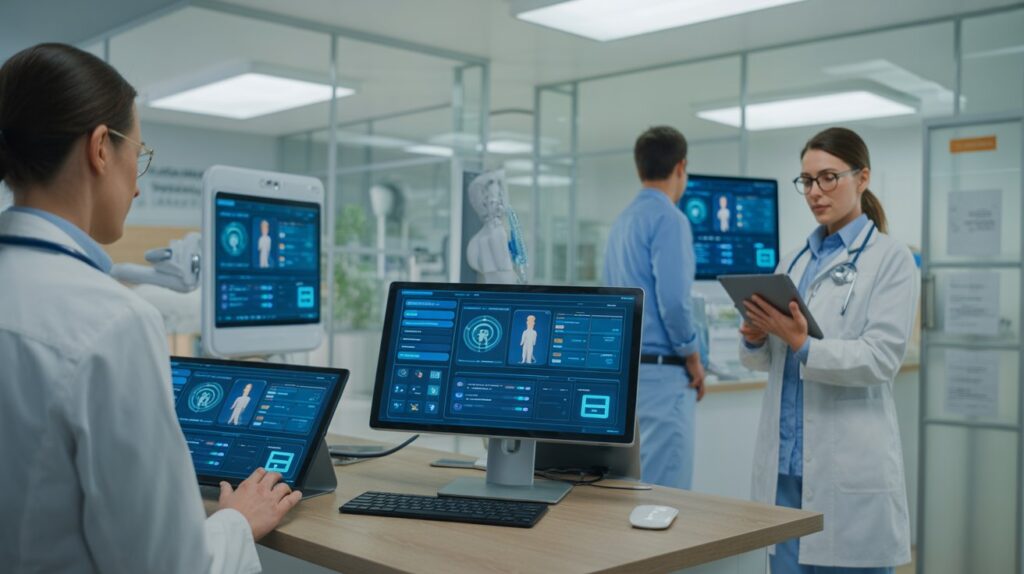In 2025, healthcare continues to experience rapid technological evolution, with electronic medical record (EMR) systems at the forefront of this transformation. EMRs have become indispensable tools for clinics, enabling healthcare providers to manage patient records efficiently, streamline administrative workflows, and ensure compliance with healthcare regulations.
The right EMR system can significantly enhance patient care, reduce errors, and improve operational efficiency. However, with numerous EMR options available, choosing the system that best fits a clinic’s needs can be overwhelming. This article provides an in-depth guide to the best EMR systems for clinics in 2025, highlighting their features, advantages, and considerations to help healthcare providers make informed decisions.
Understanding EMR Systems
An Electronic Medical Record (EMR) system is a digital version of a patient’s paper chart. EMRs store medical and treatment histories, lab results, prescriptions, and other clinical data within a single clinic or healthcare practice. Unlike
Electronic Health Records (EHRs), which are designed to be shared across multiple healthcare settings, EMRs are primarily used internally.
EMR systems offer many advantages, including:
-
Quick access to patient information: Providers can retrieve records instantly.
-
Reduced paperwork: Less manual documentation saves time and reduces errors.
-
Improved patient safety: EMRs flag potential drug interactions and allergies.
-
Enhanced regulatory compliance: EMRs facilitate adherence to HIPAA and other regulations.
-
Data analytics: EMRs allow clinics to analyze patient trends and outcomes for better decision-making.
Top EMR Systems for Clinics in 2025
The EMR market in 2025 is diverse, with systems catering to clinics of all sizes. Below is a detailed overview of the top EMR systems available for clinics.
Epic Systems
Epic Systems is a leader in EMR software, widely used in hospitals and large healthcare systems. Its comprehensive features include scheduling, billing, telehealth, and analytics. Epic stands out for:
-
Scalability: Suitable for both small and large practices.
-
Interoperability: Enables seamless data exchange across various platforms.
-
Advanced analytics: Offers tools for population health management and predictive analytics.
Epic is particularly ideal for clinics seeking a robust, integrated solution that supports growth over time.
Oracle Health (formerly Cerner)
Oracle Health, after acquiring Cerner, has strengthened its EMR capabilities. It is known for:
-
Cloud-based infrastructure: Offers secure remote access.
-
Patient tracking: Helps clinics monitor patient outcomes effectively.
-
Scalability: Can accommodate practices of varying sizes.
Oracle Health is especially valuable for mid-to-large clinics that require a reliable, cloud-based system with advanced reporting tools.
eClinicalWorks
eClinicalWorks is a cloud-based EMR system popular among small to medium-sized practices. Key features include:
-
Customizable templates: Designed for specific specialties.
-
Telehealth integration: Supports virtual consultations.
-
Patient engagement tools: Includes patient portals and appointment reminders.
Its affordability and comprehensive functionality make it ideal for independent clinics seeking a flexible EMR solution.
Athenahealth
Athenahealth is known for its intuitive interface and comprehensive integration with practice management and billing. Key benefits include:
-
Ease of use: Minimal training required for staff.
-
Cloud-based access: Enables providers to manage records from anywhere.
-
Integrated billing: Streamlines revenue cycle management.
Athenahealth is well-suited for small and mid-sized clinics looking for a full-featured, easy-to-use system.
AdvancedMD
AdvancedMD is an EMR and practice management system that integrates charting, billing, and patient engagement tools. Features include:
-
Customizable workflows: Adaptable to clinic-specific needs.
-
Telemedicine support: Facilitates virtual appointments.
-
Comprehensive reporting: Helps track performance metrics and patient outcomes.
AdvancedMD is ideal for growing clinics with complex workflows and high patient volumes.
Kareo
Kareo is a cloud-based EMR system designed specifically for small practices. Its features include:
-
User-friendly interface: Easy for staff to adopt.
-
Affordable pricing: Cost-effective for independent providers.
-
Integrated practice management: Combines scheduling, billing, and EMR functionality.
Kareo is perfect for solo practitioners or small clinics that want a simple, reliable EMR solution.
NextGen Healthcare
NextGen Healthcare is designed to meet the needs of specialty and ambulatory care providers. Key highlights include:
-
Customizable templates: Tailored to various specialties.
-
Telehealth capabilities: Enables virtual care delivery.
-
Analytics and reporting: Tracks patient outcomes and clinic performance.
NextGen is ideal for clinics with specialized care requirements and complex workflows.
CureMD
CureMD is a cloud-based EMR system recognized for its flexible, specialty-specific solutions. Key features include:
-
SMART cloud platform: Ensures fast, secure access to patient records.
-
Comprehensive modules: EHR, practice management, and electronic billing.
-
Regulatory compliance: HIPAA-compliant and regularly updated.
CureMD is well-suited for clinics seeking a customizable system that accommodates multiple specialties.
Key Features to Consider When Choosing an EMR
When evaluating EMR systems, clinics should consider the following:
-
Interoperability: The ability to share patient data with other systems.
-
Customization: Specialty-specific templates and workflows.
-
User-friendly interface: Minimal training required for staff.
-
Telehealth integration: Support for remote consultations.
-
Data security: Robust encryption and HIPAA compliance.
-
Scalability: The system should grow with your practice.
-
Reporting and analytics: Essential for performance tracking and quality improvement.
-
Customer support and training: Access to reliable support and resources.
Benefits of Implementing an EMR System
Implementing a modern EMR system offers numerous benefits:
1. Improved Patient Care
EMRs provide providers with comprehensive, real-time patient information, reducing errors and improving diagnosis and treatment plans.
2. Operational Efficiency
Digital records streamline scheduling, billing, and documentation, allowing staff to focus on patient care rather than administrative tasks.
3. Enhanced Communication
EMRs facilitate communication between providers, specialists, and patients, ensuring coordinated care and better outcomes.
4. Cost Savings
Reduced paperwork and more efficient billing processes lead to significant financial savings over time.
5. Regulatory Compliance
Modern EMR systems help clinics comply with healthcare regulations, minimizing the risk of penalties.
6. Data Analytics
EMRs allow clinics to analyze patient populations, track trends, and implement quality improvement initiatives.
Challenges and Considerations
Despite their benefits, EMR systems present challenges:
-
Implementation Costs: Initial investment, hardware, and training can be significant.
-
Data Migration: Transitioning from paper or legacy systems can be complex.
-
User Resistance: Staff may resist change or require extended training.
-
Technical Issues: System downtime or glitches can impact clinic operations.
-
Ongoing Maintenance: Regular updates are essential for optimal performance.
How to Choose the Right EMR System
Selecting the right EMR system involves a thorough evaluation of clinic needs. Steps include:
-
Assessing Practice Requirements: Consider clinic size, specialties, workflow, and patient volume.
-
Comparing Features: Evaluate which EMR systems offer the functionalities your clinic requires.
-
Budgeting: Factor in costs for implementation, subscription, training, and maintenance.
-
Seeking Peer Recommendations: Consult other healthcare providers and read unbiased reviews.
-
Requesting Demos: Test multiple EMR systems to determine ease of use and suitability.
Conclusion
Choosing the best EMR systems for clinics in 2025 is a critical decision that affects patient care, operational efficiency, and regulatory compliance. By thoroughly assessing your clinic’s needs, comparing available systems, and considering costs and functionality, healthcare providers can select the ideal EMR solution. Implementing the right system ensures improved patient outcomes, streamlined workflows, and a future-ready practice capable of adapting to evolving healthcare trends.
Frequently Asked Questions (FAQs)
1. What is the difference between EMR and EHR?
EMRs are digital versions of patient charts used within a single clinic, while EHRs are designed to be shared across multiple healthcare organizations.
2. How long does it take to implement an EMR system?
Implementation typically ranges from a few weeks to several months depending on clinic size, system complexity, and staff readiness.
3. Are cloud-based EMR systems more secure than on-premise systems?
Cloud-based EMRs often provide robust security and regular updates, but security depends on the provider’s protocols.
4. Can EMR systems integrate with other healthcare software?
Yes, many EMRs offer interoperability with billing software, lab systems, and EHR platforms to streamline data sharing.
5. What are the costs associated with EMR systems?
Costs include setup, subscription, maintenance, training, and potential upgrades. They vary based on practice size and features required.
6. How can EMRs improve patient engagement?
EMRs often include patient portals, appointment reminders, telehealth options, and educational resources, enhancing communication and satisfaction.
7. Are EMR systems suitable for small clinics?
Yes, several EMRs like Kareo, Athenahealth, and eClinicalWorks are specifically designed to meet the needs of small clinics.












